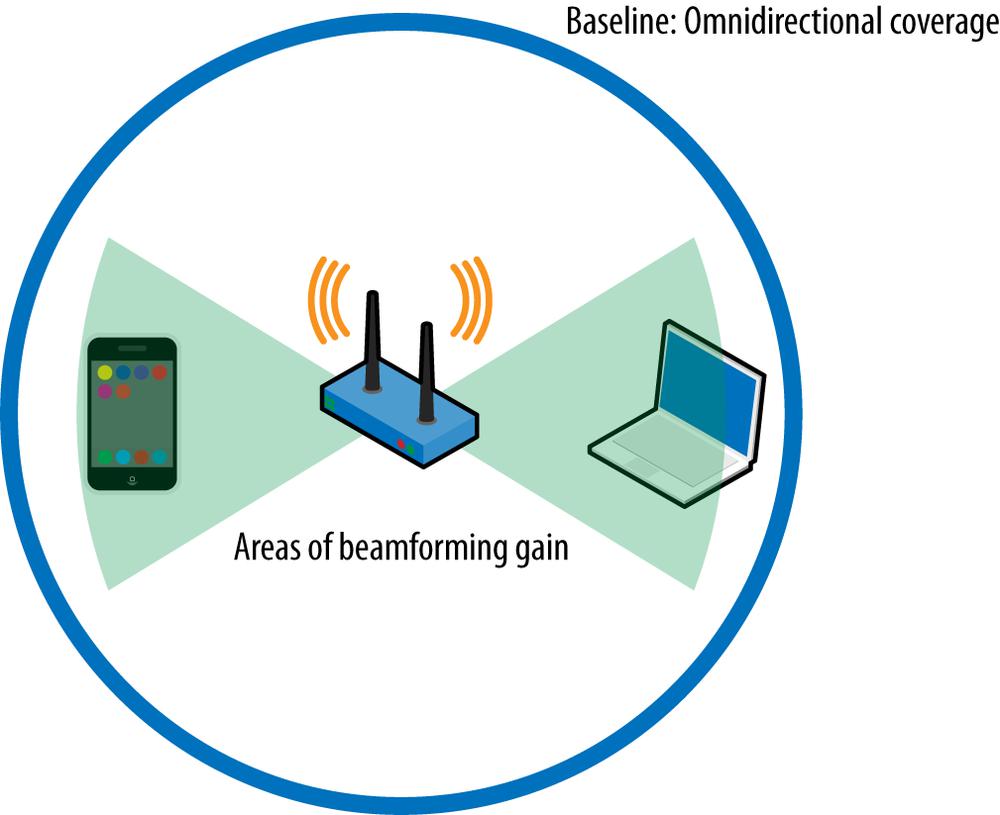While the concepts of beamforming have been around since the 1940s, the technology is currently playing a key role in improving modern wireless communication standards such as Wi-Fi and 5G. In combination with MU-MIMO technologies, beamforming helps users get more precise connections that boost their data speeds.
What is beamforming?
Beamforming is a technique that focuses a wireless signal towards a specific receiving device, rather than have the signal spread in all directions, like from a broadcast antenna. The resulting direct connection is faster and more reliable than it would be without beamforming.
The nature of electromagnetic waves is that signals radiate in all directions from a single antenna, unless blocked by a physical object. In order to focus the signal in a specific direction, to form a targeted beam of electromagnetic energy, multiple antennas in close proximity broadcast the same signal at slightly different times. The overlapping waves will produce interference, which in some areas is constructive (making the signal stronger), and in other areas destructive (making the signal weaker or undetectable). When executed correctly, this beamforming process focuses a signal to a specific direction.
The mathematics behind beamforming is very complex (the Math Encounters blog has an introduction, if you want a taste), but the application of beamforming techniques is not new. Any form of energy that travels in waves, including sound, can benefit from beamforming techniques; they were first developed to improve sonar during World War II and are still important to audio engineering. But we're going to limit our discussion here to wireless networking and communications.
Benefits and limits of beamforming
Focusing a signal in a specific direction lets you deliver a higher signal quality to the receiver, which then means faster information transfer and fewer errors, without having to boost the power of the broadcast. Because beamforming can also be used to reduce or eliminate broadcasting in other directions, it can help reduce interference for users trying to pick up other signals.

Limitations of beamforming mostly involve the computing resources required; other scenarios exist where the time and power resources needed by beamforming calculations end up negating its advantages. But improvements in processor power and efficiency have made beamforming techniques affordable enough to build into the latest consumer wireless equipment, as well as enterprise-grade wireless hardware.
Another limitation is that beamforming’s benefits diminish the farther away a receiver is from a transmitter.
Wi-Fi beamforming in Wi-Fi 6
The latest generation of Wi-Fi, now known as Wi-Fi 6, was originally known as 802.11ax. The 802.11ax protocol itself is the next generation following the 802.11ac standard, but with better naming through the Wi-Fi Alliance. For example, 802.11ac is now known as Wi-Fi 5 and 802.11n is simply Wi-Fi 4.
While beamforming has been around since Wi-Fi 4, improvements were made in Wi-Fi 5 and now Wi-Fi 6. Beamforming requires the use of MIMO (multiple input multiple output) technology in order to send out multiple overlapping signals. With the development of Wi-Fi 5 in 2016, there is now a set of specified beamforming techniques for Wi-Fi equipment that allow it to interoperate in a vendor-neutral way (different receivers can work with different routers).
Beamforming also supports multi-user MIMO, also known as MU-MIMO, which allows multiple users to communicate simultaneously with multiple antennas on the router. MU-MIMO uses beamforming to make sure communication from the router is efficiently targeted to each connected client. Wi-Fi 6 also increased the number of antennas supported from four to eight, which improves data rates and extends the range for signals to specific clients.
Beamforming will also be a key component of Wi-Fi 7, the next generation of Wi-Fi (also known as 802.11be). Coordinated beamforming will exploit the capability of modern multi-antenna access points to spatially multiplex their stations, while jointly nullifying adjacent neighboring non-associated stations.
While this technique can be also be achieved with a joint multi-access point sounding scheme, coordinated beamforming can take advantage of a simpler sequential sounding procedure that will be a part of Wi-Fi 7. In addition, coordinated beamforming does not require joint data processing, as each station transmits and receives data to and from a single access point, diminishing backhaul needs. This will deliver substantial throughput and latency enhancements while limiting complexity (more details are discussed here).
Along with other improvements in Wi-Fi 7, coordinated beamforming aims to unlock access to gigabit speeds and low-latency communications for even more applications for businesses and consumers.
5G and beamforming
With 5G networks rolling out for smartphones and other wide-area networking purposes around the world, beamforming is a key core technology here as well. Because 5G frequencies operate along the millimeter wavelength (mmWave), they are more prone to disruption from objects that interfere, such as walls and other barriers.
Beamforming helps create more reliable connectivity by allowing a transmitter to focus the transmission in a specific direction towards a mobile device, vehicle or IoT device.
Beamforming will also work with massive MIMO, in which large numbers of antennas at a 5G base station direct beams to user devices both horizontally and vertically in order to improve throughput and efficiency.
Keith Shaw is a former Network World senior editor and writer of the Cool Tools column. He is now a freelance writer and editor from Worcester, Mass. Contributing writer Josh Fruhlinger also contributed to this report.
Join the Network World communities on Facebook and LinkedIn to comment on topics that are top of mind.








